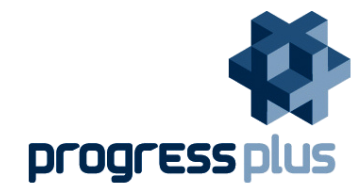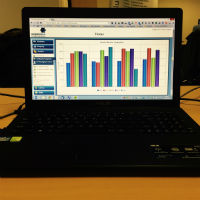 If you are a manufacturing business, you will be familiar with the old adage, “you cannot manage what you don’t measure.” Specifically, if you are the owner of a job shop or a contract manufacturing facility, it is important to understand the current state of your business through the use of real time key performance indicators or KPIs in your manufacturing software.
If you are a manufacturing business, you will be familiar with the old adage, “you cannot manage what you don’t measure.” Specifically, if you are the owner of a job shop or a contract manufacturing facility, it is important to understand the current state of your business through the use of real time key performance indicators or KPIs in your manufacturing software.
The challenge for manufacturers is understanding what to measure, then setting a goal or standard metric by which your current state is measured against also known as benchmarking and then putting corrective actions into place to help you achieve or surpass these goals in a regular, sustainable fashion.
What to measure – KPIs in Manufacturing?
Key performance indicators should be uniquely personal to your business. However, for most small and mid-sized manufacturers there are the obvious indicators which EVERY manufacturer should consistently measure at least on a monthly (or even weekly) basis. These indicators should represent a cross-section of your business focusing on the key elements of customers, productivity, vendors/suppliers, and financial.
For example, when a business establishes their customer indicators, these indicators should focus on:
- quote backlog
- quote win rate
- order backlog in weeks or pounds
- new orders placed this week/month
- on-time performance
When the business establishes productivity metrics
- these indicators should focus on utilisation by work centre or department
- efficiency by work centre or department
- throughput in days both from a production standpoint (lead days from first time entry to first shipment)
- administrative throughput (lead days from order date to first shipment)
- overbooked or under booked work centres
- rework hours and scrap cost
- direct vs. indirect hours.
For vendor metrics, the shop should establish metrics for vendor on time performance, average lead time by vendor, acceptance rate by vendor, and valuation of stock and inventory.
Finally, key financial indicators should focus on customer and vendor ageing, past due invoices, average days to pay (customers and vendors), and current cash position.
How to measure?
Now that you have established what you need to measure, you will want to spend time evaluating on how to measure.
If you are like most small companies you should quickly come to the conclusion that without some level of manufacturing software system to capture the data in real time, there will be significant manual efforts required to get the data that support the compilation of these metrics.
As a result, you will want to evaluate ways to acquire this data in real time through an automated means that is tightly integrated with your ERP solution.
Manufacturing organisations require a production system that eliminates waste through all steps in the process to build a product. Companies using software systems work to reduce costs, inventory and cycle time – the period from when an order is taken until the product ships to the customer. A complete production control system should focus on the needs of the customer by improving on-time deliveries, decreasing costs and eliminating quality defects.
 Make KPIs visible in your manufacturing software
Make KPIs visible in your manufacturing software
It is important to have meaningful measurements in place within a business, in order to monitor performance. By assigning numbers, it can help us to understand what is happening and communicate this to others. It can also help us to set targets and take appropriate action to make improvements. Measurements are useful at all levels throughout an organisation but it is important that the connections between the various measurements are understood and that we measure to take action not just to record history.
Establishing key performance indicators (KPIs) is critical for driving continuous improvement in your manufacturing business. Every shop employee should be aware of how the shop is performing against these key indicators and be rewarded for their level of contribution in meeting or exceeding these goals.
The data should be posted on a shop bulletin board or better yet, through the use of real-time data on monitors posted in strategic locations throughout the shop. The data should be presented in such a way that is easy to understand (pie charts, graphs, etc. are the best), is timely, and illustrates the overall trend of the company. Finally, these results should be used by key managers to drive decision making and improvements from the shop floor to the top floor.
ProgressPlus Remote Access KPI Module
ProgressPlus by Berkeley Myles Solutions have always provided KPI and report functionality within their software system. However, recognising the major trends in mobile and big data they have provided an additional module to the system which allows users to access their configurable reports instantly, anytime, anywhere. With the advent of regular mobile use through tablets and smart phones this module makes it quick and easy for users to access key information.
With other software systems, users are constrained to remote connection software i.e. logging in through the VPN. With the ProgressPlus Remote Access KPI module, employees that are not in the office or on holiday can access business information through the internet via any web browser, any device, anywhere in the world.
When asked about the remote access module which can be viewed on tablets, PCs, smart phones, Tony MacBride, MD of Berkeley Myles Solutions said:
“The module provides a live link to real time information to help you make the right decisions and manage the business. You can configure dashboards and reports based on stakeholders and user job roles to enable you to act on relevant data quicker. For instance, you can have a dashboard for directors to access top level management information, a dashboard at reception for visitors or a shop floor dashboard to improve communication with staff. The module is relevant to all manufacturing companies, has all the basic functions they need and KPIs are provided in a mixture of graphs and data. The reason it was designed was to provide users a simple way of quickly showing critical company data react immediately to issues.”
Trend analysis can make your business better. Big data has been a term that has made the headlines. But what does this mean for your business? Well, you can derive revenue from data. The KPI module lets you analyse the data in your manufacturing business. It is critical that you put the information in the system but more importantly it is essential that you get actionable data out of the system. Output makes a big difference as it helps move the business forward.
Tony said: “This module can promote a culture of change. With the sharing of information, targets, efficiency, how your suppliers are performing as well as how your business is performing, it is enabling better communication between management and staff. In addition, it could be used as a sales tool to develop customer confidence and credibility. For example, you can prove to clients you are in control and show how well you can do the job.”
As part of Berkeley Myles Solutions ongoing commitment to its customers they give existing ProgressPlus users the opportunity to view the latest features of the system and make suggestions for future enhancements at user groups.
Tony commented: “Part of this year’s user group format was used for a pre-launch of the remote access module and the customer feedback was positive. They are excited and can envision where it can go and difference it will make to their business.”
Today’s business environment has dictated a change in owner and manager mind set. You can no longer afford to run your business without a proper system or based on one person’s gut or intuition. The stakes are too critical and the implications are too monumental. Every manufacturer should embrace the continuous improvement cycle of measuring what is important for the business, establishing metrics and benchmarking against those metrics, and rewarding employee behaviour that directly impacts the accomplishment of those metrics. Only then, can you expect to grow your business to the next level.

